If you’re getting into astronomy or stargazing, you’ve probably been thinking about telescopes. You might have encountered the terms Refractor, Reflector, Newtonian, Dobsonian, and even Schmidt-Cassegrain Telescope. You may have wondered what all these types of telescopes are. In this article, I will answer the question, “What is a Newtonian telescope?”
In this article, you get
A solid understanding of the Newtonian design
A review of the advantages and disadvantages of Newtonian Telescopes
A look at alternatives to Newtonians
By the end of this article, you’ll know what a Newtonian Telescope is and much more!
Let’s dive right in.
Recommended For You
WHAT IS A NEWTONIAN TELESCOPE?
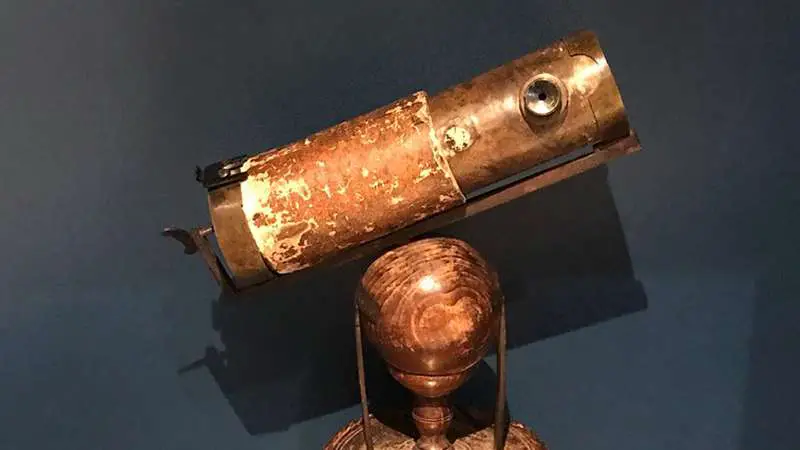
A Newtonian telescope is one type of reflecting telescope that Sir Isaac Newton developed in the late 1600s.
These reflector telescopes use a concave mirror in the rear of the telescope tube and a flat diagonal mirror near the front to reflect light through an eyepiece on the telescope’s side.
Newtonian telescopes are simple in design and easy to construct, making them popular among amateur astronomers. They are the least expensive design compared to other types of telescopes.
However, they do have some drawbacks. The most significant is that the two mirrors frequently need to be collimated (realigned). I’ll cover more disadvantages a little later in this article.
HOW DOES A NEWTONIAN TELESCOPE WORK?
As almost everyone knows, light travels in a straight line. Newtonian telescopes use two mirrors to reflect and concentrate light to produce an image.
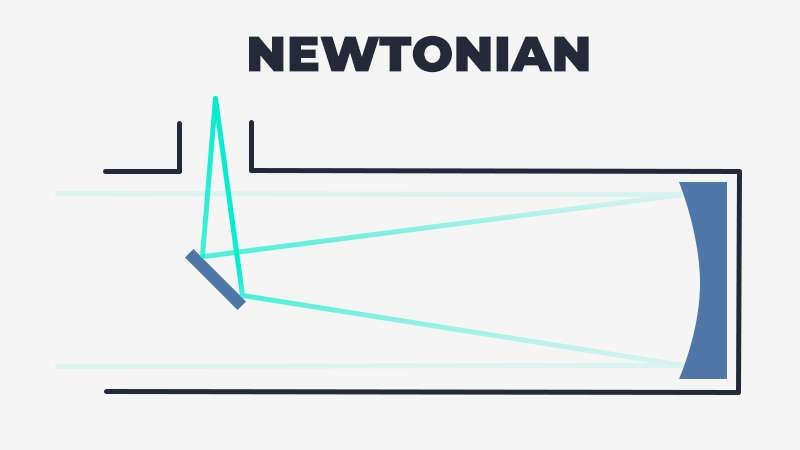
PRIMARY MIRROR
A parabolic primary mirror at the far end of the telescope reflects and concentrates light to a smaller flat secondary mirror near the front.
SECONDARY MIRROR
A flat diagonal secondary mirror near the front of the telescope is held in place by a metal frame called a spider. Light is reflected sideways from the secondary mirror to the eyepiece on the side of the telescope.
EYEPIECE
The eyepiece is on the side of the tube, near the front. Light from the secondary mirror enters the eyepiece. The eyepiece magnifies the images and can move back and forth to achieve the desired focal point.
ADVANTAGES OF A NEWTONIAN TELESCOPE
There are many benefits to using a Newtonian telescope over other types of telescopes.
- They are cheaper to build and maintain
- They offer a wider field of view than most other designs
- The large aperture of their parabolic mirrors allows a lot of light to be gathered, making them ideal for observing faint distant objects
- They don’t suffer from chromatic aberration
The Newtonian reflecting telescope is one of the simplest designs and is usually the first telescope purchased by visual astronomers. They are also great for astrophotography.
CHROMATIC ABERRATION
Chromatic aberration is an optical effect that occurs when different wavelengths of light pass through a lens and don’t meet at the same focal plane. The resulting image has color fringing because the various wavelengths of light pass through the lens at slightly different angles due to the dispersion of light through glass.
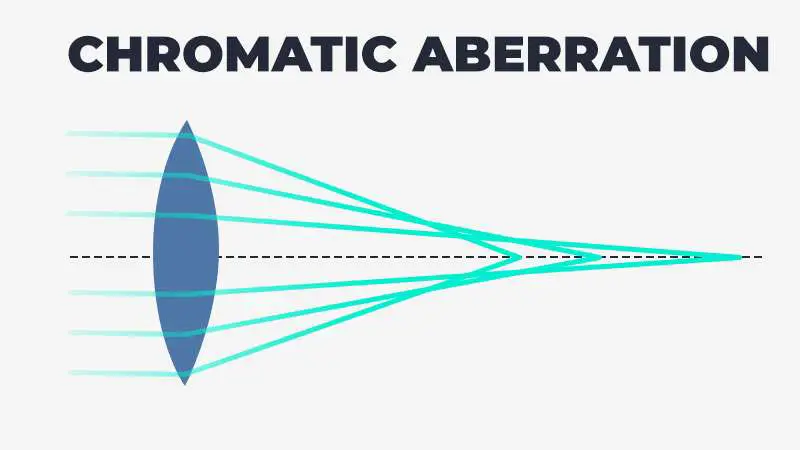
Achromatic lenses or telescopes with correcting lens elements minimize chromatic aberration. These are apochromatic refractors. Chromatic aberration is not a problem in reflecting telescopes. To learn more about refractors, read my article Refractor Telescope vs Reflector. For more info on the earliest telescope design, read my article Keplerian vs Galilean Telescope.
WIDE FIELD OF VIEW
A wide field of view allows you to see more of the sky at once, which is especially useful for finding faint objects. It also makes tracking objects as they move across the sky easier.
DISADVANTAGES OF A NEWTONIAN TELESCOPE
There are three main disadvantages of Newtonian telescopes.
As previously mentioned, the most significant drawback of Newtonian Telescopes is that the two mirrors in reflector telescopes can quickly become misaligned by transporting the telescope.
To fix this issue, you have to do a process known as collimation.
COLLIMATION
Collimation involves realigning the concave primary and flat secondary mirrors so that the light beams reach the eyepiece as close to parallel as possible. A collimated beam of light is one whose photons travel in parallel. A perfectly collimated beam would be a single ray of light with no divergence.
For more information about collimation, read my article How to Tell if Telescope Needs Collimation.
Another disadvantage of Newtonian Telescopes is Coma.
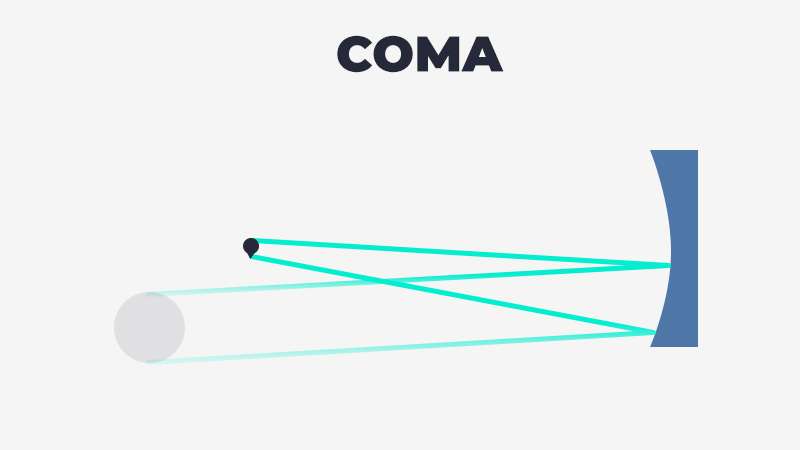
COMA
Coma is an optical aberration near the edge of the field of view. It makes Stars look like little comets. The refractive index near the border of the primary parabolic mirror is different than at the center. The off-axis aberration causes the Stars to have this funny shape.
VARIATIONS OF THE NEWTONIAN TELESCOPE
Other types of Newtonian Reflector Telescopes overcome some of the drawbacks. I’ve listed them below.
CATADIOPTRIC TELESCOPES
Catadioptric telescopes are hybrid design reflecting telescopes that use mirrors and lenses to gather and focus light. The main difference with catadioptric telescopes is that the primary mirror is spherical. The spherical mirror acts as a coma corrector to address the issue with the paraboloidal primary mirror of Newton’s telescope.
The most common type of catadioptric telescope is the Schmidt-Cassegrain telescope. Still, there are some others, which I’ve listed below.
SCHMIDT-CASSEGRAIN TELESCOPES
A Schmidt-Cassegrain telescope lets light in through a large corrector plate (lens) at the front of the telescope before hitting a spherical primary mirror at the back.
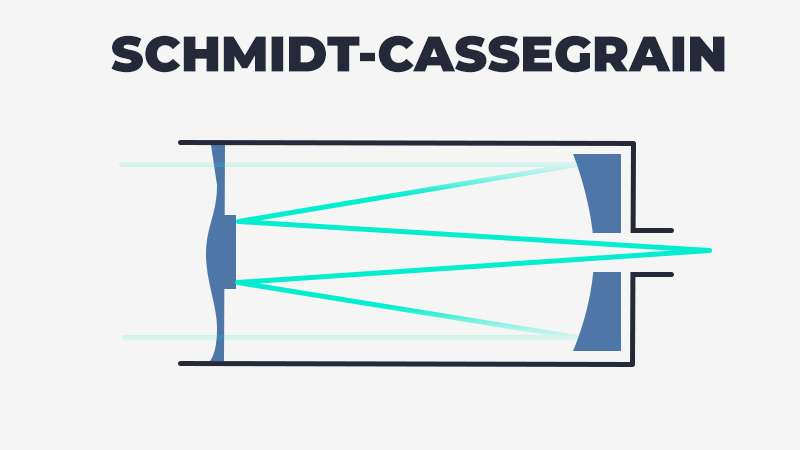
The purpose of the corrector lens is to compensate for the aberration caused by the spherical primary mirror. The spherical primary mirror at the back of the tube reflects light to a secondary mirror near the front. The light is reflected again through a hole in the primary mirror. The eyepiece is behind the primary mirror. One advantage of the Schmidt-Cassegrain telescope is that it is very compact for its focal length.
SCHMIDT-NEWTONIAN TELESCOPES
A Schmidt-Newtonian telescope also has a corrector plate (lens) at the front of the tube and a spherical primary mirror.

These two elements correct the spherical aberration. Unlike a Schmidt-Cassegrain, a Schmidt-Newtonian telescope has a flat secondary mirror that reflects the gathered light to the side of the tube.
JONES-BIRD TELESCOPES
A Jones-Bird reflector telescope also uses a spherical primary mirror.
The flat secondary mirror is similar to a Newtonian in that it reflects light to the side-mounted eyepiece.
Inside the eyepiece is an objective lens that minimizes the spherical aberrations caused by the curved mirror.
The lens is similar to a Barlow lens since it also increases the telescope’s effective focal length.
It’s also worth mentioning a word about Dobsonian Telescopes.
DOBSONIAN TELESCOPES
Read my separate article about Dobsonian Telescope vs Newtonian to learn all about this type of telescope.

Dobsonians are usually large telescopes with apertures of 12 inches (300 mm) or more. Dobsonian telescopes are well suited for visually observing astronomical objects such as nebulae, galaxies, and planets.
To learn more about seeing planets with a telescope, read my articles below.
- Can You See Planets With A Telescope?
- How To Find Jupiter With a Telescope?
- Can You See Mars With A Telescope?
- Can You See Saturn With A Telescope?
But, can you use a telescope to see the flag on the moon?
Last, but not least, read my articles Why is my telescope upside down?, How to Clean Telescope Mirror: 11-Step Guide, and DIY Solar Filter Telescope.
If you’re new to the world of telescope mounts, read my articles Types of Telescope Mounts and Equatorial Telescope Mount vs AltAzimuth.
FREQUENTLY ASKED QUESTIONS
WHAT IS THE DIFFERENCE BETWEEN A NEWTONIAN TELESCOPE AND A REFRACTOR TELESCOPE?
The main difference between Newtonian and refractor telescopes is that a Newtonian is a reflecting telescope that uses mirrors. A refractor telescope uses lenses.
WHICH IS BETTER, REFRACTOR OR NEWTONIAN?
A Newtonian telescope can see faint objects like galaxies and nebulae for anyone on a budget. Refractor telescopes tend to be more expensive and have a narrow field of view but can produce a better image.
WHAT TELESCOPE DESIGN IS BEST FOR VIEWING PLANETS?
Newtonian telescopes are better for deep-sky objects, while refractor telescopes are better for planetary observations. Newtonian telescopes have a larger aperture and can gather more light, which is necessary for observing faint objects.
CONCLUSION
This article has provided an in-depth look at Newtonian telescopes, from how they work to their advantages and disadvantages.
This information should help you decide whether a Newtonian model is a suitable choice for you. Don’t forget about accessories, such as a Dew Heater for your Newtonian.
Remember that the type of telescope you choose is just one factor in getting great views of the night sky. But can you use your Newtonian for terrestrial viewing?
It’s also essential to pick a good location with minimal light pollution.




